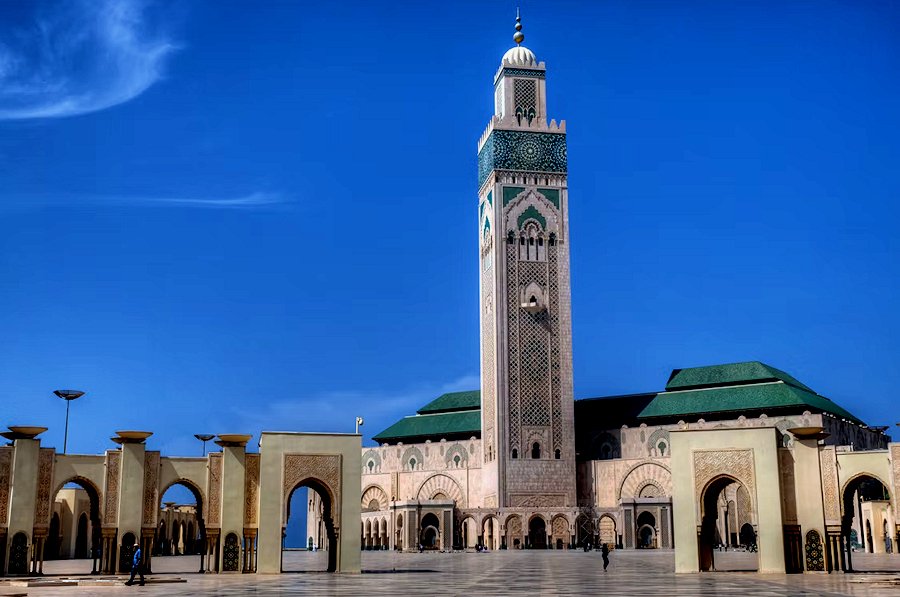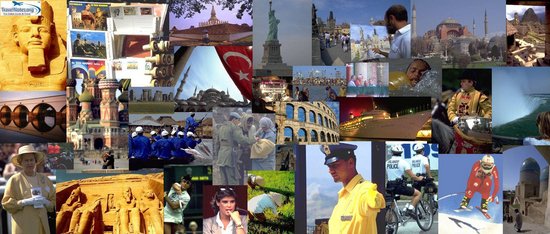Travel Notes: Destinations: Africa: Morocco - Casablanca Travel Guide.
Short URL: https://tnot.es/CMN
Travel Guide For Visitors to Casablanca
Discover Casablanca beyond the film. From Hassan II Mosque to vibrant markets, art deco architecture to modern cafés; a guide to the largest city in Morocco. Share on Facebook
Economic Capital
Casa (as locals call it) is Morocco's economic powerhouse, a working city where you'll experience authentic Moroccan urban life without the tourist circus.
 Add a Business -
Add a Location -
Add a Lodging - Add Travel Content
- Add URL
- Travel Services.
Add a Business -
Add a Location -
Add a Lodging - Add Travel Content
- Add URL
- Travel Services.
The Real Casablanca Awaits
Forget Humphrey Bogart and Ingrid Bergman, the real Casablanca is far more captivating than any Hollywood romance.
Morocco's largest city pulses with an energy that's distinctly modern yet deeply rooted in tradition.
While tourists flock to Marrakech's souks and Fez's medina, savvy travellers are discovering that Casablanca offers something entirely different; a glimpse into contemporary Morocco where business suits mingle with djellabas, and where the call to prayer echoes between gleaming skyscrapers.
This isn't your typical Moroccan tourist trail destination, and that's precisely what makes it brilliant.
From the world's second-largest mosque to stunning art deco architecture, from bustling fish markets to sophisticated rooftop bars, Casablanca rewards curious travellers with layers of discovery.
Getting Your Bearings - Casablanca's Key Districts
Ain Diab - Coastal Escape
Casablanca's answer to the French Riviera stretches along the Atlantic coast.
This modern district combines beach clubs, shopping centres, and upmarket restaurants with a distinctly Moroccan flavour.
It's where Casa's well-heeled residents come to see and be seen.
Habous Quarter - The New Medina
Built by the French in the 1930s, this planned neighbourhood successfully blends traditional Moroccan architecture with modern urban planning.
It's an excellent spot for souvenir shopping without the medina maze experience.
The Medina - Old Meets New
Unlike the sprawling medinas of Fez or Marrakech, Casablanca's old town is refreshingly compact and navigable.
Built in the 18th century, it's enclosed by partially preserved ramparts and offers a gentler introduction to Moroccan medina life.
The atmosphere here is more residential than commercial; you'll find locals going about their daily business, rather than persistent carpet sellers looking for yours.
Ville Nouvelle - Art Deco Dreams
The French colonial legacy lives on in this district, where you'll find the highest concentration of art deco buildings in Africa.
The area around Boulevard Mohammed V showcases this architectural treasure trove, with the Central Market (Marché Central) serving as the neighbourhood's bustling heart.
Must-See Attractions - Beyond the Tourist Trail
Central Market (Marché Central)
This art deco gem buzzes with activity from dawn until dusk.
The seafood section is particularly impressive;- Casa's coastal location means the fish is impossibly fresh.
Even if you're not buying, it's a feast for the senses and a window into local life.
Hassan II Mosque - Architectural Marvel
Standing majestically on the Atlantic coast, this is the only mosque in Morocco that non-Muslims can visit.
The statistics are staggering; it's the world's second-largest mosque, with a minaret reaching 210 metres into the sky.
The guided tours reveal intricate craftsmanship that took 10,000 artisans six years to complete.
Practical tip - Book tours in advance, especially during peak season. Tours run several times daily except Friday mornings.
Rick's Café - Embrace the Tourist Trap
Yes, it's touristy.
Yes, it's themed around a film that wasn't even shot here, but Rick's Café (248, Bd Sour Jdid) is surprisingly well-executed; housed in a beautifully restored riad with live jazz and classic cocktails.
Sometimes embracing the obvious tourist experience is part of the fun.
Villa des Arts
Morocco's contemporary art scene is thriving, and this cultural centre showcases the best of it.
The rotating exhibitions feature both established and emerging Moroccan artists, offering insights into the country's modern creative identity.
Architectural Treasures - Casa's Art Deco Legacy
Casablanca boasts Africa's largest collection of art deco architecture; a legacy of French colonial ambition and 1930s modernist dreams.
The style here isn't merely imported European fashion; it's been adapted to local climate and culture, creating something uniquely Moroccan.
Notable Buildings to Seek Out
Cathédrale du Sacré-Cœur - Now a cultural centre, this former cathedral exemplifies art deco's clean lines.
Cinéma Rialto - Still functioning as a cinema, showcasing the style's commercial application.
Hôtel Lincoln - A perfectly preserved example of 1930s glamour.
Walking Tip
Start at Place Mohammed V and work your way down Boulevard Mohammed V for the best concentration of architectural gems.
Tourist Map of Casablanca
Use the Tourist Map of Casablanca to help you decide where to stay in Casablanca based on travel budget, preferred location, planned must-see attractions and local must-do activities.
Culinary Adventures - Where Casa Eats
Moroccan Flavours with Urban Flair
Casablanca's food scene reflects its cosmopolitan character.
Traditional Moroccan dishes get contemporary presentations, while international cuisine finds its footing alongside tajines and couscous.
Must-Try Dining Experiences
Contemporary Dining
Restaurant du Port de Pêche - Ultra-fresh seafood in a no-frills setting.
Street Food Heroes
The area around Marché Central offers excellent street food.
Try the grilled sardines, fresh orange juice, and makouda (potato fritters) from local vendors.
Traditional Moroccan
Dar Beida - Hidden in the medina, serving authentic home-style cooking.
La Sqala (Bd des Almohades) - Set in a restored bastion, offering traditional dishes in a historic setting.
Practical Travel Information
Currency and Costs
The Moroccan dirham (MAD) is the local currency.
Casablanca is pricier than other Moroccan cities but still offers excellent value for European visitors.
Budget around £30-50 per day for mid-range travel.
Getting There and Around
Mohammed V International Airport (CMN) connects Casablanca to major global destinations.
The Casa Port train station links to other Moroccan cities, while local transport includes reliable taxis and trams.
Casa Tramway
The Casa Tramway is modern, efficient, and connects major attractions.
Buy tickets at stations - it's far cheaper than taxis for longer distances.
Language and Communication
Arabic and Berber are official languages, but French is widely spoken due to colonial history.
English is increasingly common in tourist areas and among younger locals.
When to Visit
Spring (March-May) and autumn (September-November) offer the most comfortable weather.
Summer can be humid, while winter brings occasional rain but mild temperatures.
Shopping - From Souks to Malls
Modern Shopping
Morocco Mall, one of Africa's largest shopping centres, combines international brands with local boutiques.
The aquarium and IMAX cinema make it a rainy-day option.
Traditional Markets
The Habous Quarter offers a more organised souk experience than traditional medinas.
You'll find quality crafts, leather goods, and textiles without the overwhelming maze atmosphere.
What to Buy:
Argan oil products (Morocco's liquid gold).
Ceramics and pottery.
Leather goods from local artisans.
Phosphate-based skincare products.
Textiles and carpets.
Day Trip Options
El Jadida - Portuguese Heritage
This coastal town features a well-preserved Portuguese fortress and excellent seafood.
The underground cistern is particularly atmospheric.
Mohammedia - Beach Town Escape
A short train ride north of Casablanca, this relaxed coastal town offers beaches, golf courses, and a more laid-back pace.
Rabat - Royal Capital
An hour from Casablanca by train, Morocco's capital offers imperial monuments and coastal charm.
The Hassan Tower and Kasbah of the Udayas are UNESCO World Heritage sites worth the journey.
Looking Forward
Casablanca doesn't try to be Morocco's most beautiful city; that honour belongs to others.
Instead, it offers something perhaps more valuable: authenticity.
This is Morocco at work, Morocco looking forward, Morocco balancing tradition with ambition.
The city rewards travellers who arrive without preconceptions, who understand that sometimes the most interesting destinations are the ones that don't immediately charm you.
Casablanca grows on you slowly, revealing its secrets to those willing to look beyond the surface.
Whether you're using Casa as a gateway to Morocco or as a destination in its own right, approach it with curiosity rather than expectation.
You might just find that the real Casablanca is more compelling than any Hollywood fantasy.
Planning a Visit to Casablanca
Allow at least two full days to appreciate Casa's character properly.
Three days lets you explore more deeply and perhaps venture on a day trip.
This is a city best experienced on foot, so pack comfortable walking shoes and prepare to discover Morocco's most dynamic urban centre.
More City Travel Guides
City Guides: Cities in Africa - Cities in America - Cities in Asia - Cities in Australasia - Cities in Latin America - European Cities and Regions.
More From Travel Notes
Travel Notes Online Guide to Travel
Africa - Asia - Caribbean - Europe - Middle East - North America - Oceania - South America.
The Travel Notes Online Guide to Travel helps visitors plan their trip with country and city travel guides, local tourist information, reviewed web sites, and inspiring travel content.
Travel and Tourism Guides on Travel Notes
 If you find Travel Notes useful, please take a moment to
like us on Facebook and share with your friends on social media.
If you find Travel Notes useful, please take a moment to
like us on Facebook and share with your friends on social media.
Share on Facebook
Travel Resources
.
Travel & Tourism With Industry Professionals.


















